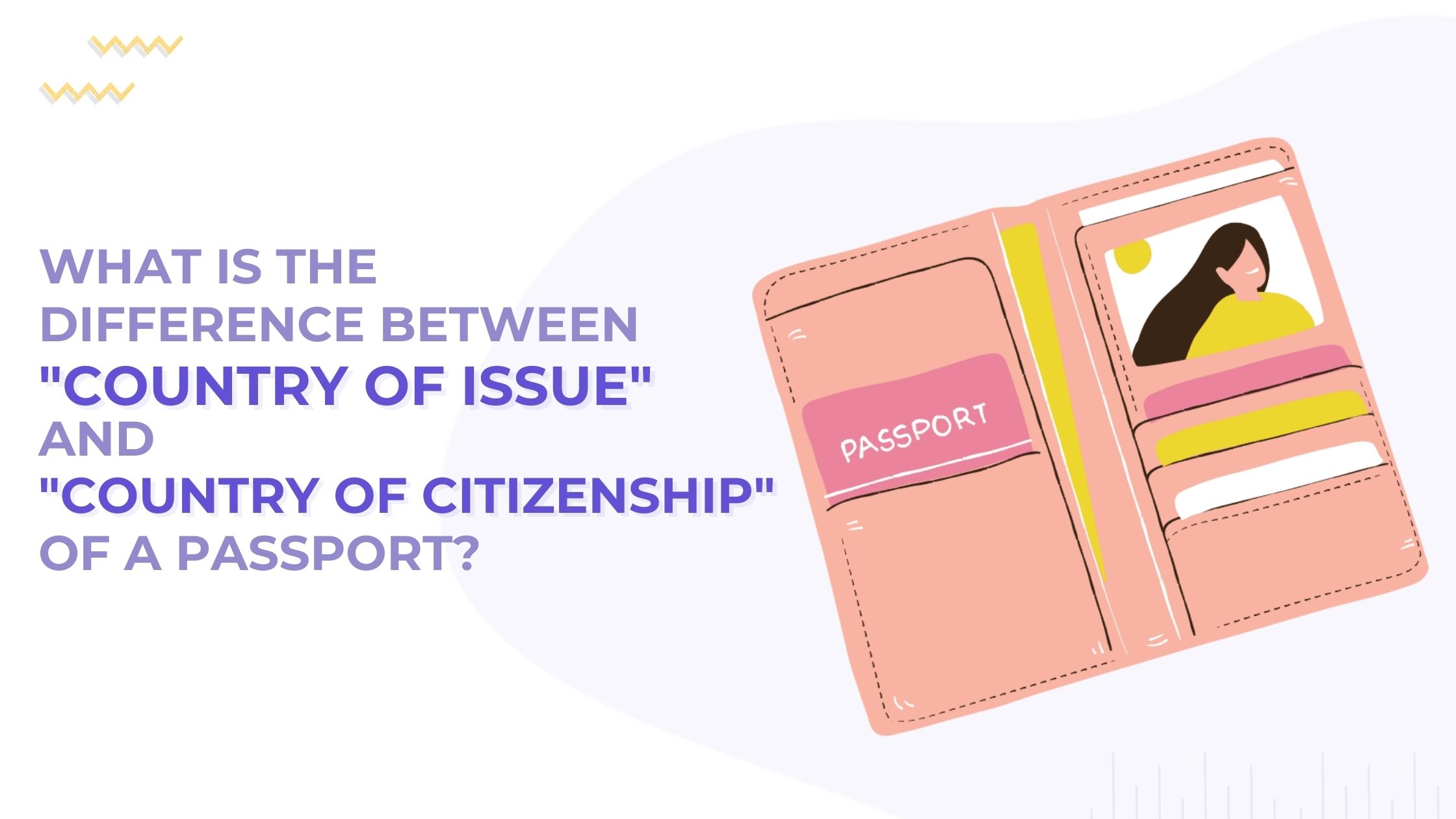If you have a passport issued by a consulate in a foreign country, you may think that the Country of Issue and the Country of Citizenship should be the same. However, there are some forms that require both to be filled in. So, what is the difference between a passport’s “Country of Issue” and “Country of Citizenship”?
Let’s find out in the specifics of this article!
What Is The Difference Between the “Country of Issue” and “Country of Citizenship” Of A Passport?
The difference between the country of issue and the country of citizenship of a passport is an important one. The country of issue is the nation that issued the passport, while the country of citizenship is the nation that grants its citizens rights and obligations based on their nationality.
In many cases, these two countries are the same.
For example, if you hold a United States passport, then both your country of issue and your country of citizenship is the United States.
Let’s see another example. If you are a citizen of the United Kingdom but getting your passport from the UK Consulate in Hong Kong, then the United Kingdom is your country of issue.
Even though this situation may involve crossing borders or navigating consulates and embassies located in other countries, remember that UK passports will always be issued by UK authorities.
That makes the UK your “country of issue” even though you may have had to travel elsewhere to obtain it.
This is because consulates and embassies of a country in a foreign country are still regarded as part of the country for which they are operating in the foreign country.
This is why it’s important to note that some forms may ask for the “place of issue” or “authority” who issued the passport (more on that in the next section).
In other cases, however, they can be different. For instance, there are some nations that grant passports to people who do not have any formal ties or recognition from such countries.
This means that even though their passport may say “Country X” as its country of issue, they may not actually be considered citizens of that country by the governing laws or regulations.

Photo by Mariam Soliman on Unsplash
This is particularly common in the Middle Eastern region, where Palestinians and other non-citizen populations are able to obtain certain passports from countries in which they are not recognized as citizens.
This difference between a passport’s “country of issue” and its “country of citizenship” should be taken into consideration when traveling abroad.
Even though a person may possess a passport from one country, their rights and obligations may vary depending on their actual citizenship status in that nation.
What Is The Difference Between the “Place of Issue” and “Country of Citizenship” Of A Passport?
The Country of Issue refers to which government authority actually issued your passport – this is typically your home country’s government/embassy/consulate office abroad. The Country of Citizenship indicates which nation you hold citizenship with; it doesn’t have to be related to where your passport was issued from.
In gist, the main difference between the Country of Issue and the Country of Citizenship lies in the ownership of the passport.
Therefore, it is essential when filling out forms to indicate both the Country of Issue and the Country of Citizenship so that the appropriate records can be kept.
Let’s say you were born in one country but hold a passport issued by another, you would need to indicate both countries when asked which country you are from.
This allows governments and other institutions to accurately record who is coming in and out of their borders.
For example, if you are an American citizen living in France and lose your passport, France may issue you with a temporary emergency document known as a laissez-passer.
In this case, your home country (e.g., USA) would be listed under “country of citizenship” while France would be listed under “place of issue”.
Another example is, my current New Zealand passport was issued by the British High Commission in India, even though I’m a citizen of New Zealand. This means that my “place of issue” is Britain and not New Zealand.
It’s important to know and understand the difference between these terms so that you can provide accurate answers when asked about them on official forms or applications.
Knowing what your country of citizenship and country of issue is will help ensure that all relevant documentation is properly filled out and submitted correctly.
In some cases, non-citizens may also obtain a passport from their country of residence.
For instance, if you are an immigrant to the United States and have permanent residency status, you may be eligible for a US passport.
In this case, your home country would still be listed under “country of citizenship” while the United States would be listed under “place of issue”.
It is important to understand the distinction between the two terms when traveling internationally.
While most countries will look at both fields when determining who should or should not be allowed entry, certain countries may only consider one field when making these decisions.
Knowing what each field means can help ensure that your travel experience is as hassle-free as possible.
FAQs
What Is The Difference Between The “Country Of Issue” And “Country Of Citizenship” Of A Passport?

Photo by ConvertKit on Unsplash
The “country of issue” refers to the country responsible for issuing a particular passport, while the “country of citizenship” indicates the citizen’s nationality. The two are usually the same, but not always; for example, an individual may possess a French passport issued by Germany.
That is if they were born in France but currently live in Germany.
If The “Country of Issues” and “Country of Citizenship” are different for my passport, does it affect my citizenship?
It’s important to remember that just because your passport was issued from a foreign consulate does not mean that your citizenship changed. It simply means that a foreign government recognized your citizenship with your home nation and allowed you to have an official travel document.
In this case, both countries should be listed as the same on documents or forms requiring such information.
What Is Your “Country of Citizenship” and “Country of Issue” If You Have A Dual Citizenship?
The “Country of Issue” and the “Country of Citizenship” are two different elements that appear on a passport. The Country of Issue is the nation or government that issued the particular passport, while the Country of Citizenship is the one that recognizes an individual as its citizen.
For example, if an individual has a German passport, then Germany would be listed as their Country of Issue.
However, if they have dual citizenship with another country like Italy, then Italy would be listed as their Country of Citizenship.
In some cases, these two designations can also be different than where a person actually resides.
Can I have more than one passport?
Photo by Jon Tyson on Unsplash
Yes, you can have more than one passport. Depending on your country of residence and nationality, you may be eligible to obtain multiple passports. It is important to note that each country has its own rules and regulations regarding dual citizenship and the issuance of multiple passports.
How Long Does It Take To Obtain a Passport?
Generally, it takes 4-6 weeks to obtain a passport once the necessary documents have been submitted. However, this timeframe can vary depending on the country of issue and the type of passport being requested. Thus, make sure to plan ahead of time.
What Is The Difference Between the “Country of Issue” and “Country of Citizenship” Of A Passport For Refugee Passports?
The country of issue is the nation that issued the passport. This could be different from one’s country of citizenship or nationality. For example, refugees often receive travel documents (informally known as “refugee passports”) from countries where they are residing even though their country of citizenship may be elsewhere.
Similarly, people from American Samoa may obtain a passport issued by the US Department of State, yet they remain citizens of American Samoa.
In other words, the country that issues a passport may not change one’s citizenship or nationality.
It simply grants them permission to travel and indicates that they can be readmitted back into the country that issued it even if their primary citizenship lies elsewhere.
A refugee passport does not replace one’s original citizenship but merely allows one to travel safely back to their country of origin should circumstances arise for such necessity.
What Is The Difference Between Nationals and Citizens?
The distinction between citizens and nationals is based on the jurisdiction where the passport was issued. A citizen of a country has a right to live in that country, while a national may not necessarily have this right. Nationals are people who possess special ties to their home country.
This can include ancestry or having completed military service in the home country’s army.
They may also be eligible to receive certain benefits from their homeland, like access to consular services when abroad.
What Can You Do If You Have a Passport from a Country of Issue Other Than Your Country of Citizenship?
Having a passport from a country other than your own, often referred to as an “alien” passport, can give you access to travel opportunities that would not be available with only the passport issued by your own country. Often, you can use an alien passport to enter foreign countries.
You can do this without having to obtain a visa before traveling.
However, it is important to understand the difference between the ‘country of issue’ and the ‘country of citizenship’ when using an alien passport.
The country issuing your passport is responsible for granting entry into its territory based on its requirements and conditions.
The laws regarding entry may differ depending on the country you are entering.
How To Distinguish The Country of Issue and Country of Citizenship Of A Passport?
The country of issue is the nation that issued the passport while the country of citizenship is the nation of which the holder is a legal citizen. It appears on your passport in two different places, usually separated by a line.
The first entry may be either “Country of Issue” or “Nationality”, while the second entry should say “Citizenship” or “Citizen Of”.
Will The “Place Of Issue” On A Passport Also Be The Place Of Citizenship?
No, the “place of issue” on a passport does not always indicate the place of citizenship. For example, some people from American Samoa can get a passport issued by the US Department of State but they remain citizens of American Samoa.
In this case, the country where their passport is issued – the US – would be referred to as the “place of issue” while American Samoa remains the “country of citizenship”.
Why Do Passport Forms Ask About “Country of Issue” and “Country of Citizenship”?
When you apply for a passport, most forms will ask you to enter your “country of issue” and “country of citizenship.” The country of issue is the country that has issued the passport. Most people do not have multiple passports from different countries.
Thus, this is usually the same as their country of citizenship.
However, in some cases, such as refugees who have been granted asylum in another country, they may have a passport from one country but are citizens of another – thus having two different countries listed on the form.
This is why the form asks for both the “country of issue” and “country of citizenship.” ‘
Can I Skip Filling Out the Country of Citizenship and Pick a Country of Issue on My Passport?
No. Even if you are issued a passport by another country, you must always enter your country of citizenship on the application form. The country of issue is the country whose government has issued you your passport. This could be different from your actual country of citizenship.
The country of citizenship is the country to which you owe allegiance or for which you are legally registered as a citizen.
It is important to note that these two terms are not interchangeable when it comes to passports.
What Are The Advantages of Having Different Countries Listed on Your Passport?
The foremost advantage of having different countries listed on your passport, depending on the circumstances, is that you may be eligible to receive certain benefits or special passports from the country of issue. Moreover, having dual citizenship may open you up to more travel opportunities.
This is because some countries require that visitors possess a valid passport issued by their country of origin in order to enter.
It could also facilitate easier access to resources and services available in both countries.
No matter what type of document you possess (e.g., refugee travel document, etc.), it is important to correctly list both your country of citizenship and your country of issue on any application form requesting this information.
This will ensure that your documentation is accepted without any issues when traveling or seeking other types of international assistance.
Summing Up!
When looking at a passport, you will usually find two distinct fields – one for the country of issue and another for the citizenship or nationality of the holder.
The country of issue is the nation that issued your passport, while your citizenship or nationality describes where you originate from and is not necessarily related to the issuing country.







